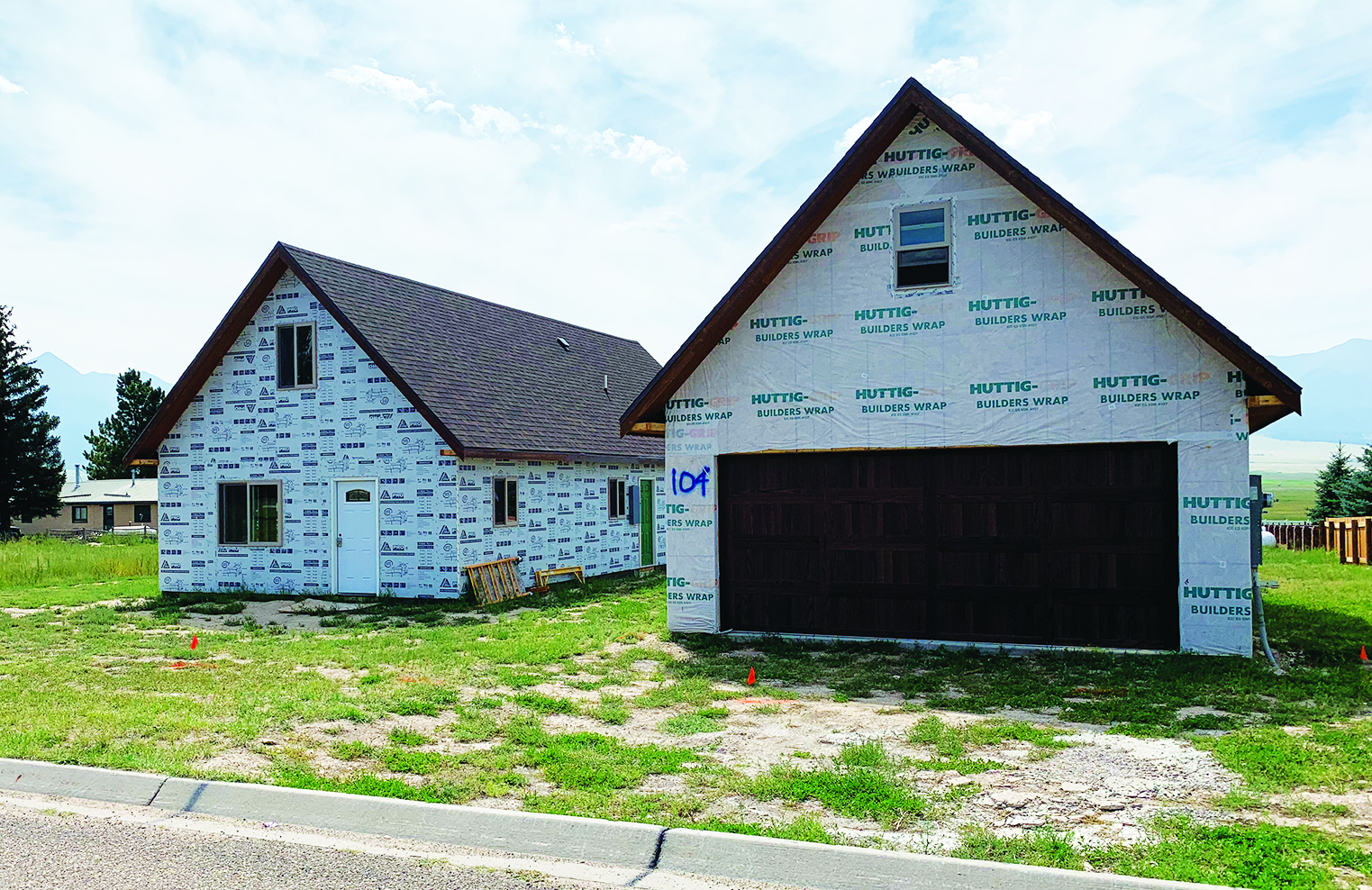“What are we supposed to do? Do we walk away from the house we are building here in Westcliffe? Do we walk away and just let the bank foreclose on our future home?” That was the question Kristin and Anthony Dalla had for the Round Mountain Water and Sanitation District during the February 15 meeting.

Round Mountain announced on January 1 of this year that they would be placing a moratorium on all new water and sewer taps in the district. Any taps that had already been purchased before the January 1 deadline were allowed to continue construction even it wasn’t finished. However, for the Dalla’s, they had not received any of the information about the moratorium even though their house had been under construction at the end of 2021. The Dalla’s house is part of the Shadow Ridge subdivision in Westcliffe just north of the city. When they came to the district to buy a water and sewer tap, they were shocked to find out that they would not be allowed to do so.
The Round Mountain board of directors discussed if they would allow a variance for this singular instance, but it was clear that they were worried that if they allowed a variance that it would set a precedent for anybody else that tried to start construction projects after the January 1 moratorium deadline. The Dallas’ comments had made it clear that they did not subscribe to the local newspaper and information about the moratorium was not posted online in any of the Round Mountain web pages, or the Town of Westcliffe’s building application website. “Why didn’t the town of Westcliffe alert us about the moratorium when we took out our permit this past year?”
After about an hour-long conversation, it was decided that Round Mountain would convene in March to discuss the permitting process for this instance. The board also heard from Greg Quinones, a developer that had purchased land in the area and had not realized that a moratorium was going to be put in place on January 1 even though he had been talking directly with the district for months. “My plan had been to build almost eight units of rental duplexes and now I’m not sure if I will be able to convince a bank to be able to start this process now or even in the near future.”
It might have been inevitable that this type of situation would occur due to the struggles that Round Mountain is facing trying to build and finance a new waste disposal and sewage treatment plant. The current moratorium on new water and sewage treatment taps hangs a dark economic cloud over the towns of Westcliffe and Silver Cliff. For over the past six years the district has spent hundreds of thousands of dollars conducting studies, exploring new plans, and eventually securing millions of dollars in grants and loans from various state and federal organizations. “It always seemed that a solution to our problems was just around the corner,” explained District Operations Manager Dave Schneider to the Dallas during the meeting. “But what we did not realize was that the costs and feasibility of building the waste treatment plant continued to grow year after year despite our best efforts.”
The problems of the special district
The Tribune has been following the story of the struggles the district has faced over the past decade and the main problem is that the Round Mountain special district is large, but despite the overall physical size of the district they currently only have around 650 total accounts. Trying to maintain and manage a district that covers two towns and be able to afford the construction costs of a $16 million facility became untenable with only 650 paying accounts. So, this past fall the district decided that they would scrap the plans for the mechanical wastewater treatment plant and start searching for alternative options that wouldn’t cost as much. The small size of the towns of Westcliffe and Silver Cliff that give them their quaint charm is also the problem that makes it nearly impossible for the district to build the much needed wastewater treatment plant.

In addition to the small size of the two towns, there is also the problem of the soil that the district sits on. When the original wastewater treatment lagoons were built in 1974 it wasn’t well understood at the time that the soil the treated water was pumped back into became clogged fairly easily over time. These pipes that return the water back into the ground after it’s been treated in the lagoon system are known as infiltrators and almost immediately those infiltrators started to cause the district problems. Over the past decade as the district tried to come up with ways to replace the aging and ineffective lagoon system it became clear that trying the same infiltrating system was not going to work. This left the district with only one real option to deal with wastewater after it had been treated, and that was to return the water to the nearby Grape Creek watershed.
While returning water back into creeks and rivers is not unusual in the modern world, increasing pollution standards have made it all but impossible for the district to get the water clean enough to dump back into the Creek without an expensive mechanical treatment plant. New Federal and Colorado Environmental Protection laws that will go into effect by 2027 require that the wastewater be treated to such a high standard that existing treatment options are not possible. It was these high standards that forced the district to consider building the prohibitively expensive $16 million mechanical treatment plant, but because of the small size of the district, paying for such an expensive project and keeping it staffed with trained personnel was not possible.
The history of Round Mountain
Over the past decade, as Round Mountain has struggled to find a way to either repair or replace its wastewater treatment facilities, a lot of fingers have been pointed at the district for not planning and saving money in the past. The problem with this accusation of the district is that it’s only true in retrospect and it misses the history behind why the district was formed in the first place. In addition, such accusations of mismanagement fail to take into account the historical situation of Round Mountain’s formation in the 1970s.
The Wet Mountain Tribune archives show that the district was originally formed in 1969 partially in response to the Clean Water Act that had been passed and was to go into effect in 1972. The town of Silver Cliff and the town of Westcliff, both had their own water, and to a lesser extent, wastewater treatment facilities. However, these facilities mostly consisted of individual septic fields and cesspits that had to be pumped on a regular basis. In addition, neither town had consistent or safe wells and drinking water to supply the towns. Silver Cliff, for example, got most of their water from an abandoned mineshaft that filled with water. That water was pumped up to a wooden water tower where the current metal water towers currently sit. This water tower frequently froze and had to be drained completely in the wintertime. This would cause the wood from the water tower to dry during that time; and in the spring when water was once again pumped into the wooden water tower it would leak excessively until the wood had reabsorbed moisture and tightened the seams to contain the water.
The problems for the district started almost immediately after it was created in 1969. While the people from Westcliffe and Silver Cliff had voted in favor of forming a special district that would handle both water and wastewater treatment, there was not enough money to integrate, build, and then maintain the needed systems. It wasn’t until 1974 when funding became available through the USDA that the district was able to start building and integrating the aging water systems of the two towns. [Note to readers, proceeding dollar numbers have been adjusted for inflation from 1974 into 2022 dollars. This makes comparing the original costs of the project much easier.]

Grants and loans through the rural USDA programs started to be awarded in June of 1974. Shortly after, the Colorado Department of Health added on more money, along with the Four Corners Regional Administration and the Farmers Home Administration Rural Development Act. These grants and loans totaled just under $8 million with a 40 year pay back at 5%. But it’s important to put these numbers into perspective as at the time Round Mountain only had 209 taps. There were roughly 200 houses, 31 businesses, three motels, a mobile home park, courthouse and the school. If we take the roughly $8 million and divide it by the 209 paying taps, the amount per tap totaled $29,000 for each. The system was designed to allow the number of taps to double. It more than tripled by 2000.
The new district had two ways to pay for ongoing maintenance and the new programs. Tap fees and sewer fees were the main vehicle of paying back the loan and the interest rate. At the time this would have been equivalent to $78 per month. Ongoing maintenance, and money to eventually replace the systems, was paid through a mill levy tax. While the expense for the system was high with the loans and grants, it was assumed that the district would not only be able to upgrade the aging infrastructure, but to have enough money for future investment and ongoing replacement costs.
This is where the historical context of these decisions is important. Right as the district started to receive funding in 1974, with building in 1975, inflation was at a record 11% and 9% respectively. Never before in the 20th century had inflation hit these high levels in the United States. From 1976 to 1982 inflation never fell below 6% and by 1980 it had hit a record high of 13.5%. It was not until 1984 that inflation dipped to what we would call normal levels of between 2% and 4%.
In the first decade of existence for Round Mountain, the cumulative rate of inflation was 110.8%. The problem with inflation is that it becomes very hard for local governments to deal with saving and raising rates to match the rates of inflation. It would force an elected board to constantly raise rates in an effort to try to maintain funds sufficient to maintain and replace expensive infrastructure over the decades. While the district did raise rates during that time, it was not enough to match the nearly halving value of the American dollar in that time frame. While it’s clear now that the district was unable to save enough money to replace the lagoon system and properly maintain the systems in the district, it is not accurate to make such accusations without taking into account the historically high rate of inflation and interest rates.
A possible solution
Thankfully there is a potential solution to the wastewater treatment facility. In a lucky turn of events, a former resident of Custer County who teaches at Red Rocks Community College near Golden, Colorado heard about an experimental way to treat sewage and alerted Round Mountain, knowing the problems that it was having. While the technology itself is not all that new, and has been used extensively in the oil fields to treat fracking fluid and water, it has been experimentally installed in small rural towns facing a similar problem as Round Mountain.
Director Dave Schneider has been working with a town in Oklahoma that has the system installed to see if the process will meet the strict environmental standards. While early work is promising and would reduce the cost of the project, there are many steps that the district is going to have to take to convince the state of running a pilot program, the first of its kind in Colorado. A confounding part of this new technology is that many of the USDA grants will not support an experimental pilot program. However, if the district can get approval and support for the new treatment facility the cost is estimated to be in a much more manageable $3 to $5 million range.
The Tribune will keep covering the ongoing work that Round Mountain is doing to lift the water and sewer moratorium.
– Jordan Hedberg

